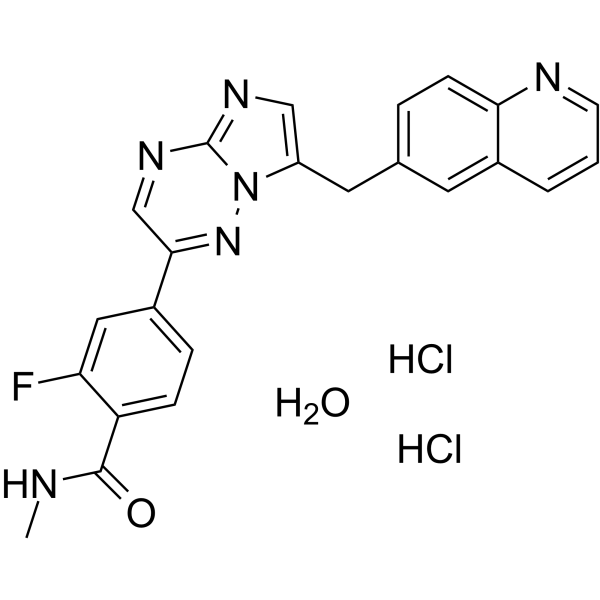| Description |
Capmatinib (INC280; INCB28060) dihydrochloride hydrate is a potent, orally active, selective, and ATP competitive c-Met kinase inhibitor (IC50=0.13 nM). Capmatinib dihydrochloride hydrate can inhibit phosphorylation of c-MET as well as c-MET pathway downstream effectors such as ERK1/2, AKT, FAK, GAB1, and STAT3/5. Capmatinib dihydrochloride hydrate potently inhibits c-MET-dependent tumor cell proliferation and migration and effectively induces apoptosis. Antitumor activity. Capmatinib dihydrochloride hydrate is largely metabolized by CYP3A4 and aldehyde oxidase[1][2][3].
|
| Related Catalog |
|
| Target |
c-Met:0.13 nM (IC50)
|
| In Vitro |
INCB28060 inhibits c-MET phosphorylation with an IC50 value of approximately 1 nM and a concentration of approximately 4 nM inhibits c-MET more than 90%, which is reversible and the effect is significantly reduced in several hours after the compound is removed and completely disappeared by 48 hours[1]. INCB28060 (0-10000 nM; 72 h) inhibits the proliferation of SNU-5, S114, H441 and U-87MG[1]. INCB28060 (0.06-62.25 nM; 2h) effectively inhibits phosphorylation of c-MET as well as c-MET pathway downstream effectors such as ERK1/2, AKT, FAK, GAB1, and STAT3/5[1]. INCB28060 (0.24-63 nM; Over night) prevents HGF-stimulated H441 cell migration[1]. INCB28060 (0.5-50 nM; 20 min) suppresses phosphorylation of both EGFR and HER-3 rapidly[1]. Cell Viability Assay[1] Cell Line: SNU-5, S114, H441 and U-87MG Concentration: 0-10000 nM Incubation Time: 72 h Result: Inhibited the cell viability of SNU-5 and S114, as well as the colony formation of H441 and U-87MG, with IC50 values of 1.2 nM, 12.4 nM, ~0.5 nM and 2 nM, respectively. Cell Migration Assay [1] Cell Line: H441 (stimulated with 50 ng/mL recombinant human HGF for 24h) Concentration: 0.24, 1, 4, 16 and 63 nM Incubation Time: Over night Result: Prevented HGF-stimulated H441 cell migration, with IC50 of approximately 2 nM, and less cell migration at 16 nM. Western Blot Analysis[1] Cell Line: SNU-5 Concentration: 0.06, 0.24, 0.98, 3.91, 15.63 and 62.25 nM Incubation Time: 2h Result: Effectively inhibited phosphorylation of c-MET as well as c-MET pathway downstream effectors such as ERK1/2, AKT, FAK, GAB1, and STAT3/5. Western Blot Analysis[1] Cell Line: H1993 cells Concentration: 0.5, 5 and 50 nM Incubation Time: 20 min Result: Suppressed phosphorylation of both EGFR and HER-3 rapidly and as effectively as the compound inhibited c-MET phosphorylation in H1993 cells.
|
| In Vivo |
INCB28060 (1-30 mg/kg; PO, twice daily, for 2 weeks) exhibits dose-dependent inhibition of tumor growth, and shows well tolerance at all doses during the treatment periods, with no evidence of overt toxicity or weight loss in U-87MG tumor mice model[1]. INCB28060 (0.03-10 mg/kg; PO, single dosage) causes inhibition of c-MET phosphorylation in S114 tumor mice model[1]. Animal Model: Female Balb/c nu/nu mice (inoculated subcutaneously with 5×106 U-87MG glioblastoma cells)[1] Dosage: 1, 3, 10 and 30 mg/kg Administration: PO, twice daily, for 2 weeks Result: Exhibited dose-dependent inhibition of tumor growth with 35% and 76% at 1 and 3 mg/kg once daily; resulted in partial regressions in 6 of 10 U-87MG tumor-bearing mice at 10 mg/kg once daily; and showed well tolerance at all doses during the treatment periods, with no evidence of overt toxicity or weight loss. Animal Model: Female Balb/c nu/nu mice (inoculated subcutaneously with 4×106 S114 tumor cells)[1] Dosage: 0.03, 0.1, 0.3, 1, 3 and 10 mg/kg Administration: PO, single dosage Result: Caused approximately 50% and 90% inhibition of c-MET phosphorylation at 0.03 and 0.3 mg/kg after administration of 30 min, and inhibition of phospho-c-MET exceeded 90% after 7 hours.
|
| References |
[1]. Liu X, et al. A novel kinase inhibitor, INCB28060, blocks c-MET-dependent signaling, neoplastic activities, and cross-talk with EGFR and HER-3. Clin Cancer Res. 2011 Nov 15;17(22):7127-38. [2]. Baltschukat S, et al. Capmatinib (INC280) Is Active Against Models of Non-Small Cell Lung Cancer and Other Cancer Types with Defined Mechanisms of MET Activation. Clin Cancer Res. 2019 May 15;25(10):3164-3175. [3]. Dhillon S. Capmatinib: First Approval. Drugs. 2020 Jul;80(11):1125-1131.
|
